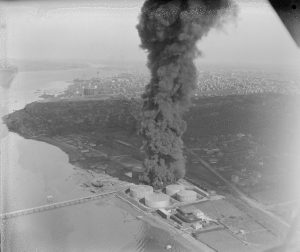MANY INJURED FOLLOWING COLLAPSE OF STEEL FRAME, FLAMES SPREAD RAPIDLY.
Tiverton, R.I., Nov. 1 — (AP) — Three men were killed and a dozen more were injured today when an oil tank being tested at the plant of the New England Terminal Company in North Tiverton collapsed. The collapse was shortly followed by an explosion and fire, which enveloped four or five big tanks nearby, containing oil.

Several workmen were reported missing immediately after the collapse of the tank and the outbreak of the fire, but since a number of men were rushed to hospitals in Fall River, it was believed they might be found there.
The known dead included a full blooded Cherokee Indian, known as “Chief GAYLOR HENSHAW,” whose home was somewhere in Oklahoma; LESTER HORNBACK, address not ascertained, and HENRY ST. PIERRE, 23, of Tiverton.
The tank being tested had been filled with water, several workmen were on top looking it over to see if it was in good condition, while several others were inspecting it from the ground before filling it with oil.
Without warning the big tank collapsed. The explosion followed shortly and the resulting fire spread to the big oil tanks nearby. Although firemen were promptly on the scene nothing they could do prevented the rapid spread of the flames.
Jefferson City Post-Tribune Missouri 1933-11-01
[The following is taken from Forgotten Tales of Rhode Island by Jim Ignasher]
Perhaps the worst disaster to occur in Tiverton was the massive fire that destroyed the New England Terminal Company on November 1, 1933.
The incident began with the installation of a new eighty-thousand-gallon oil tank. After construction was complete, workmen pumped the tank full of seawater to check for any leakage and to test the tank’s structural integrity. As the tank filled with water, three men climbed to the top to check the upper seals. As the water neared the top, the whole structure suddenly collapsed without warning.
The wreckage fell onto a pump house that contained electric motors. The resulting short circuit ignited a nearby fuel oil tank. Before the fire could be brought under control, the flames had spread to two larger fuel tanks. The intense heat generated by the flames caused two massive gasoline storage tanks to explode, which sent flaming debris hundreds of feet in all directions. Tiverton Chief of Police George Potter later reported seeing a man making his way between the two tanks just before the explosion.
The massive pillar of oily black smoke rose thousands of feet into the air and could be seen for miles. That evening, the orange glow from the conflagration was seen far out to sea. Special railroad cars loaded with firefighting chemicals used specifically for oil fires were sent from Fall River to assist in battling the blaze. Nearby residents were forced to evacuate, and some spent the next two nights sheltered in a schoolhouse.
The flames burned for more than forty-eight hours before they were brought under control. When it was over, three workmen were confirmed dead, several others were seriously injured and one man was reported missing. Several buildings were destroyed and two homes were damaged. Monetary losses were estimated to be at $1,000,000.
The incident caused some legislators to reevaluate the State’s fire prevention laws regarding oil storage tanks.
